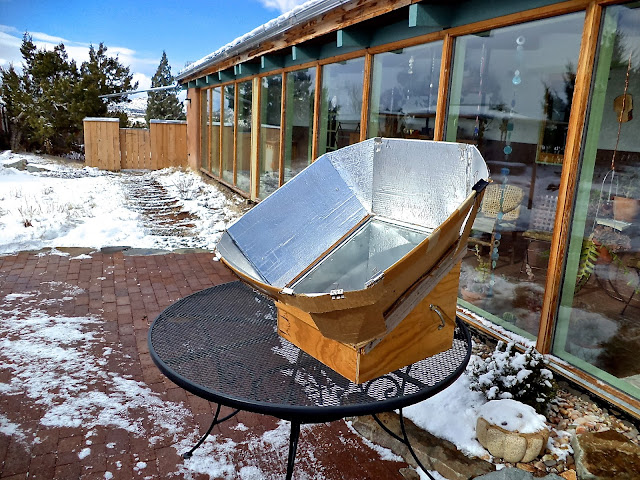It was over 3 years ago we made our cardboard solar cooker
as a prototype for a more permanent cooker as we profiled in the post:
This past spring we finally made the permanent one (above).
We adopted the plans from:
and plans included in the 1992 book,
Cooking With The Sun (Morning Sun Press)
by Beth and Dan Halacy.
(As an aside, as I was researching for this post
I noticed that Beth Halacy died earlier this year,
Dan had died some years earlier.
Many thanks to them for there contributions to the passive use of solar energy.)
We made various alterations to both plans, primarily in the dimensions and construction.
The first two photos shows the oven in the winter mode.
Excuse the above photo as the white dots are blowing snow.
Above is the original cardboard oven we made.
It served us well for 3 years.
The wood stand is to hold it in high winds because it is so light.
For the new model we used 3/8" construction grade plywood
with 1"x 1" wood ribbing to glue and nail the plywood sides together
and provide space for insulation.
Most of the plans I found on the internet use 3/4" plywood without a ribbing
but I have found that a thinner plywood with ribbing
makes for a much stronger, lighter, and cheaper box that is easier to make
and provides more space for insulation without making the box too big.
After much debate we decided to use multiple layers of cardboard for the insulation
as the alternatives presented problems with toxicity for the food in the oven.
For the inside liner I opted for a thin gauge galvanized sheet metal
with exposed edges folded over and rivets at the corners.
Once inserted it is screwed to the wood along the edges with small sheet metal screws.
Most solar ovens I have seen are painted black on the inside,
but I prefer a shiny surface to reflect heat to the pot we are using.
That is where we want the heat.
Our finished inside dimensions are approximately 14.5"x 14.5"
and the angles are 30/60 degrees to allow for the two positions for the oven-
winter mode and summer mode.
There was a lot of head scratching involved.
Once the box was finished we glued felt weatherstripping where the glass lay and added handles.
The narrow strip of metal at the bottom is to hold the glass in the winter mode.
The above photo is the winter mode
(when the sun is low in the sky)...
…and above you see the summer mode
(when the sun is high in the sky).
Once we had the finished dimensions of the box we ordered regular double strength glass ...
...and covered the edges with aluminum tape.
The photos above and below show the box in summer mode,
(please ignore the snow on the ground).
The first two photos of this post show winter mode.
For the temporary reflectors Allison glued aluminum foil to cardboard
and used binder clips to hold the pieces together
till we figure out a more permanent solution.
For all the head scratching done on designing and building this oven
the reflectors seem to be the hardest to figure out and they are a critical component.
The 8 sided reflector seems to be much more efficient than the 4 sided (see the cardboard oven above)
but also the hardest to build and attach.
Maybe next year we will come up with a more permanent solution
that could be removed easily and fold up.
In the meantime the cardboard and aluminum foil works fine.
In using the oven we often times get excessive moisture buildup on the inside of the glass
that requires creating a small opening (1/8") at the bottom of the glass for ventilation.
Also the temperature stratifies quite a bit in the inside of the oven,
so we use baking tins (as you can see above) to keep the pot as high up as possible.
We have found a 3 qt. blue or black enamel pot is best,
although we have a friend who uses a vented mason jar to cook beans.
Where the thermometer is in the photo above we get readings of up to 275 degrees
but because of the temperature stratification I think the pot actually gets much hotter.
We cook pinto and garbanzo beans, rice, soup, potatoes, baked tofu, baked chicken, etc.
For a comparison to our home made model, above is a manufactured oven that works really well.
We hope you will be inspired to start cooking with the sun.`









